How to Make Your Museum More Inclusive and Accessible

How to Make Your Museum More Inclusive and Accessible
Prioritizing inclusivity and accessibility at your museum is one of the best ways to serve your visitors and create an engaging space for all. This guide offers tips and suggestions for how to make your museum accessible. Keep reading to find out how to support your visitors and provide better experiences for everyone who wants to enjoy your museum.
Read the full article or jump to a specific section:
- Before Guests Arrive
- Visitors with Reduced Mobility
- Visitors with Limited Vision
- Visitors with Limited Hearing
- Visitors with Cognitive Disabilities
- Visitors on the Autism Spectrum
The Importance of Making Your Museum Accessible
Providing a welcoming space for people with disabilities should be a priority for businesses and museum exhibitions alike. By making your museum more accessible, you can benefit your visitors and your overall operation by helping you:
- Expand your reach: In the United States, one in four adults lives with a disability, meaning you can reach a larger audience by improving inclusivity in your museum. Accommodating more visitors can expand and diversify your community, creating an inviting environment for your visitors and staff.
- Create a safer environment: Improving your museum’s accessibility will also enhance its overall safety. When a business provides accommodations for people with disabilities, it allows them to navigate the exhibitions more comfortably and easily. Due to the curb-cut effect, those accommodations often lead to a safer environment for everyone.
- Boost your reputation: Making improvements beyond what the Americans with Disabilities Act (ADA) mandates for museums is considerate and beneficial for your guests and staff members. Your visitors will appreciate your museum’s inclusive design and attention to detail. Meeting more accessibility needs will improve visitor outlook and impressions of your museum.
Accessible museums give people with disabilities equal access to your collections, enhance visitor experiences and enable more people to explore and appreciate the displays. As a bonus, your museum can improve profits by being more accommodating to individuals with disabilities.
Before Guests Arrive
When making improvements to enhance your museum’s accessibility, you should consider your visitors’ experience interacting with your facility from the time they arrive. The following are ways you can begin accommodating your guests before they enter your museum.
Audio and Visual Signage
Helpful, easy-to-understand signage is one of the best ways to help all your visitors navigate around the parking lot and entrance. At a minimum, your museum should incorporate ADA-compliant signs to direct visitors upon arrival. Consider the following ways to make your signage more inclusive for people with disabilities:
- Use high-contrast colors.
- Utilize easy-to-read fonts.
- Provide clear audio.
- Add braille to signage.
- Use simple, straightforward pictograms.
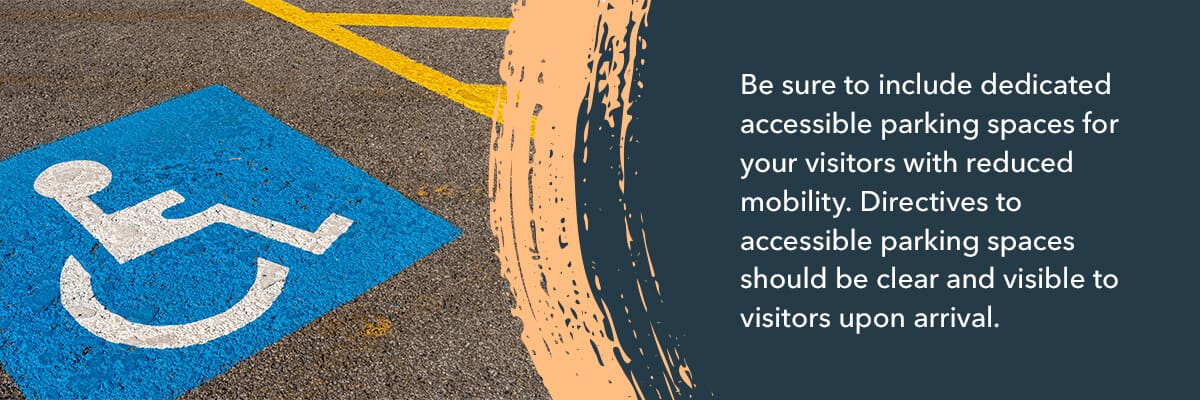
Parking
Be sure to include dedicated accessible parking spaces for your visitors with reduced mobility. These spaces should:
- Be close to any ramps or curb cuts.
- Offer a comfortable amount of space for getting in and out of the vehicle.
- Support easy access to the entrance of your museum.
Directives to accessible parking spaces should be clear and visible to visitors upon arrival.
Walkways
A museum’s walkways should accommodate all visitors, including those who use a wheelchair. Incorporate features like sloped curbs that allow visitors to easily get on and off the sidewalk, helping people navigate your facility more comfortably and conveniently.
Sidewalk braille can help individuals detect the boundary between the walkway and the parking lot. Walkways should also include clear, directive signage.
Removing Architectural Barriers
Removing architectural barriers is another effective way to support and accommodate your visitors as they arrive at your museum. The ADA Guide for Small Businesses notes the following as examples of architectural barriers:
- Steps
- Round door knobs
- Narrow aisles
- Tall counters
Museums should strive to remove barriers to give all guests equal access and make engaging with the exhibits easier.
During the Museum Trip
Museum accessibility begins in your parking lot and continues with inclusive features within your building.
Considering diverse types of disabilities and their unique needs can help your museum support more people. Review every activity visitors take part in on a regular basis, such as:
- Buying tickets at a counter.
- Exploring the gift shop.
- Stopping in the restroom.
- Navigating the exhibits.
- Traveling between floors.
By making adjustments to your museum’s features and design, you can support your guests’ needs and enhance their time spent at your facility. Putting thought and care into which accessibility upgrades will improve your visitors’ safety and enjoyment will help make their visits more comfortable. Explore the following sections for more tips and ways to make your museum inclusive.
Visitors With Reduced Mobility
A visitor’s mobility level can impact their experience at your museum in several different areas. Consider the following ways you can offer greater accessibility to museum visitors with reduced mobility:
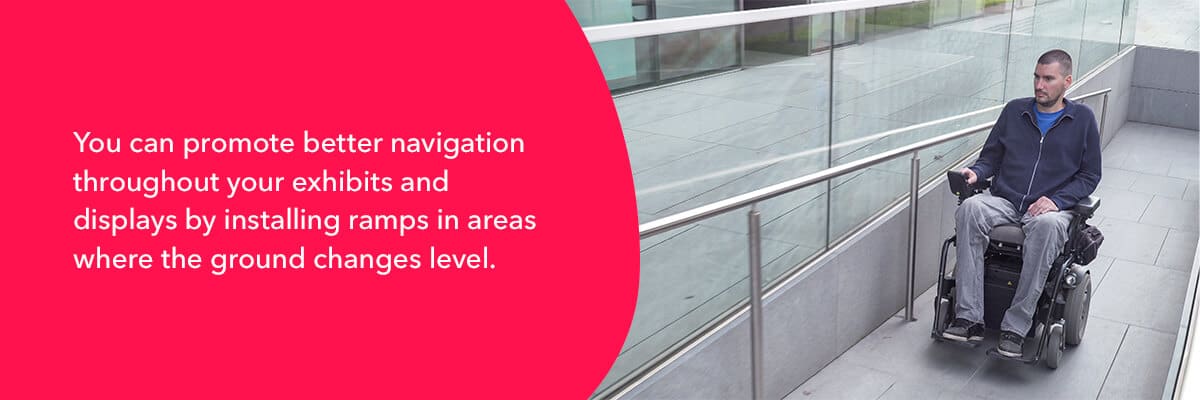
Ramps and Elevators
Ramps and elevators are a must for museums that span multiple levels and floors. These adaptions can make it easier for those who use assistive walking and mobility devices to explore your space.
If your museum has areas that are only accessible via steps or staircases, it blocks access for wheelchair users or those with limited mobility. You can promote better navigation throughout your exhibits and displays by installing ramps in areas where the ground changes level.
Reliable elevators support people with limited mobility while also offering a convenient way for all your visitors to move around and experience everything your museum has to offer.
Large Spaces
When looking for ways to accommodate your visitors with mobility limitations, consider incorporating large spaces where you can.
Open areas throughout your museum provide individuals who use wheelchairs or other mobility devices the room they need to navigate comfortably without interference. Everything from the accessible parking spaces to the museum walkways should offer ample space for those with limited mobility.
You should also consider including seating for visitors at regular intervals. A dedicated space between exhibits can give visitors with limited mobility a chance to take a seat and relax. Additionally, an area with comfortable seating options will benefit all your guests.

Lowered Counters, Exhibit Stands and Descriptions
Service counters and any other surfaces that visitors or staff utilize in your facility should be no more than 36 inches above the ground to meet ADA standards and ensure that everyone who comes to your museum can readily access your counters. If your museum is not in a position to replace all your counters with shorter options, consider temporary solutions. For example, adding supplementary desks alongside other surfaces can help accommodate those requiring lower heights.
Lower countertops can benefit those with reduced mobility as they:
- Buy admission tickets.
- Wash their hands.
- Make purchases at the gift shop.
Just as your museum should incorporate lower counters, you should also consider lower exhibit stands and descriptions. When designing your space, ensure you place all reading materials and display cases in locations that people of all heights and levels can access easily. Your museum could add secondary descriptions at a lower height to give visitors using wheelchairs a clearer view of the information.
Courtesy Wheelchairs
Another way to make your museum more inclusive for visitors with reduced mobility is by providing courtesy wheelchairs.
Whether you invest in motorized or manual options, your facility can create a more welcoming environment for wheelchair users by providing them free of charge. It is most helpful to store them near your museum entrance, where guests can see them.
By supplying wheelchairs, you can also reduce the burden on some of your visitors, who will no longer need to unload their chairs from their vehicles.
Visitors With Limited Vision
Consider these ways for your museum to enhance and uplift the experience of your visitors with limited vision:
Tactile Guide Paths
You can support those with limited sight by incorporating specialized paving that provides physical indications and warnings.
Your museum can use various tactile paving patterns to communicate with individuals with limited vision. Consider some of the following guiding and attention-grabbing designs:
- Blisters: These round, tightly spaced bumps indicate pedestrian crossings.
- Offset blisters: Paving with slightly more spread-out bumps indicates the edge of a platform surface.
- Hazard: This pattern features closely-spaced lines that communicate danger nearby.
- Directional: Directional paving uses raised lines or other textures to help guide those with limited vision.
These textures allow visitors with limited vision to understand their surroundings better and stay safer while at your museum.
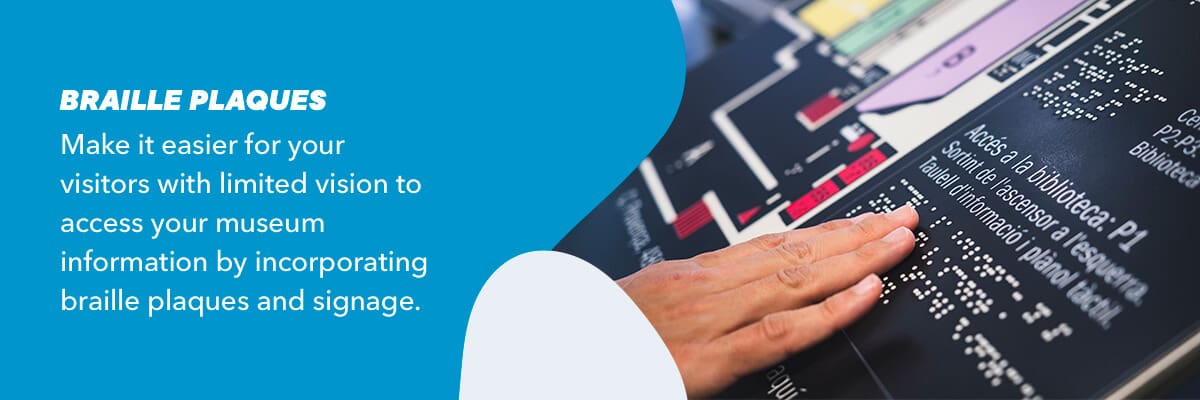
Braille Plaques
Make it easier for your visitors with limited vision to access your museum information by incorporating braille plaques and signage.
Providing braille allows your visitors to explore the facility independently. The easier it is to navigate your building, the better. Consider adding informative, directional plaques that empower individuals to find their way at their leisure. The plaques should identify the use of each room and space to give insights into the area and what visitors should expect.
Audio Guides
You can allow your visitors to experience the art and beauty of your exhibits, no matter their visual capabilities, with specialized audio guides. Audio guides are a popular feature for many visitors. For those living with blindness, listening to these recordings is a great way to learn about the exhibits and gain valuable insights into the museum.
There are various ways to maximize the benefits of these guides for everyone who visits your space. Audio guides can be directional to help your guests navigate your museum or informative to share stories and facts about the materials on display.
Tactile Exhibits
You can also support and accommodate your visitors with limited vision by providing interactive tactile exhibits. Your museum can invest in exhibit replicas that allow people to touch and hold the materials. By making your operation more interactive, guests with visual disabilities can feel their way through your pieces and engage with your exhibits on a deeper level.
Some museums choose to invest in a three-dimensional printer to produce more tactile experiences and reach wider audiences. This practice also helps preserve artifacts and materials that visitors cannot touch.
Visitors With Limited Hearing
You can improve your museum’s inclusivity by adding features that uplift visitors who are deaf and hard of hearing. Here are a few ways to boost your guests’ experiences:
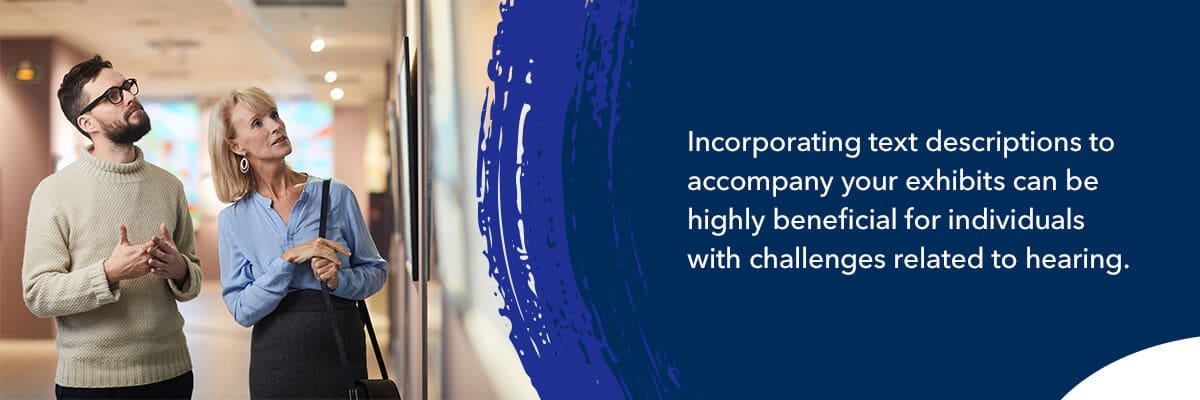
Text Descriptions of Exhibits
Incorporating text descriptions to accompany your exhibits can be highly beneficial for individuals with challenges related to hearing. Visitors can read their way through your displays and learn the same materials your audio guides provide — offering information about your exhibits through different mediums can help you broaden your audience.
Be sure to provide clear, easy-to-understand writing that shares information about the item in a concise and effective way. Too much text can be frustrating for readers and take more time than they want to spend. Instead, keep descriptions to the point and use simple, engaging language.
Subtitled Videos
Along with text descriptions, consider incorporating video content into your exhibits. These visuals should include subtitles so that visitors who are deaf and hard of hearing can follow along.
Captions on video content allow visitors with limited hearing to stay engaged and concentrate on the information. Ensure your subtitles use an easy-to-read font and high-contrast colors that make them stand out from the screen’s imagery.
Subtitled videos are beneficial for individuals who process information better when they’ve read it as well. They are also suitable for high-traffic areas in your museum that can become noisy when things get busy.
ASL Interpretation
Your museum can also accommodate visitors who are deaf and hard of hearing by providing American Sign Language (ASL) interpretation. About one million people utilize ASL as their primary means of communication. Both individuals with limited hearing and communicative challenges use sign language to learn and share with others. Providing ASL interpretations at your museum allows more people to actively engage with your exhibits.
You can utilize video content or have instructors share details about your exhibits in person. Whatever you choose, adding sign language interpretation lets you reach more people and help them understand the information through a medium that works for them.
Assistive Listening Devices
Your museum can also offer assistive listening devices to help visitors with limited hearing learn about your materials. These devices are available in a few variations, including:
- Audio induction: This type of system amplifies the sound input from a microphone for easier listening.
- FM system: An FM device transmits sound through radio waves.
- Infrared system: Infrared devices can wirelessly transmit sound to a headset receiver.
- Personal amplified system: These devices allow users to amplify sounds from their surroundings with a transmitter and headphones.
- Bluetooth system: Bluetooth utilizes Wi-Fi to transmit sounds directly to hearing aids or earphones.
Visitors With Cognitive Disabilities
Including a few simple features in your museum can better serve your visitors with cognitive disabilities. Consider these ways to improve your guests’ experiences:
Easy-To-Read Descriptions
One way you can assist your guests with cognitive disabilities is by sharing easy-to-read descriptions of the exhibits. Be sure to use simple language that readers can understand. Choosing a baseline reading level for this text can help keep your information consistent.
When crafting these descriptions, ensure your team utilizes a font style and size that is easy for visitors to see. Providing helpful written descriptions allows people to move through your facility independently. They can go at their own pace without missing out on the most important information regarding the individual exhibits.
Pictograms
Along with easy-to-read descriptions, your museum can also utilize simple pictograms to communicate with your visitors. Some of your guests will prefer to rely on imagery to navigate around your building.
Be sure you use universal pictograms with widely shared and understood meanings. People should be able to take meaning from the symbol without much confusion or delay.
If you do choose to use imagery unique to your museum, use simple symbols that are bold and easy to follow. Consistency is essential, so be sure to use your pictograms as directives and labels outside in your parking lot and entrance as well.
Visitors on the Autism Spectrum
When working on your museum’s accessibility, consider how you can better serve visitors on the autism spectrum. You can create a welcoming and more manageable environment for everyone by establishing dedicated quiet spaces.
One of the easiest ways you can accommodate people on the autism spectrum is by providing areas that are less noisy and crowded. Your guests will appreciate having sensory-friendly areas when they feel overstimulated or just need a moment to relax.
Clearly post the location of these quiet zones so all your guests know where they can go if they want to find peace and calmness.
Other Tips to Improve Accessibility
In addition to our suggestions for different groups of museum visitors, here are some additional tips for making your space more engaging and fun for everyone:
Multilingual Material
You can improve your museum’s inclusivity by incorporating multilingual material. Your guests have diverse backgrounds and can benefit from learning about your exhibits in the language they’re comfortable with.
Using multiple languages for everything from display descriptions to directional signs can make your visitors feel seen and respected.
Work With an App
Working with an app is a great way to serve more individuals and improve your museum’s accessibility. You can include an interactive map to help visitors navigate your building easily. By uploading audio and video about your exhibits onto the app, your guests can decide how they want to learn about the information. They can watch, listen or read about the materials they see in real life.
An app gives your visitors the freedom and independence to engage with the material in a way that suits them and their learning style.

Museum Accessibility for Kids
Whether your museum is dedicated to kids or incorporates kid-friendly features, there are tons of ways to improve accessibility for kids. One option is to include interactive exhibits that allow them to engage in tactile play. Some museums choose to create an inclusive play area within their building to allow kids to explore and use their imagination.
At Soft Play®️, we have everything your museum needs to create an immersive and innovative play area that your visitors will love. Our play equipment can help you create a mesmerizing world that the kids will never forget.
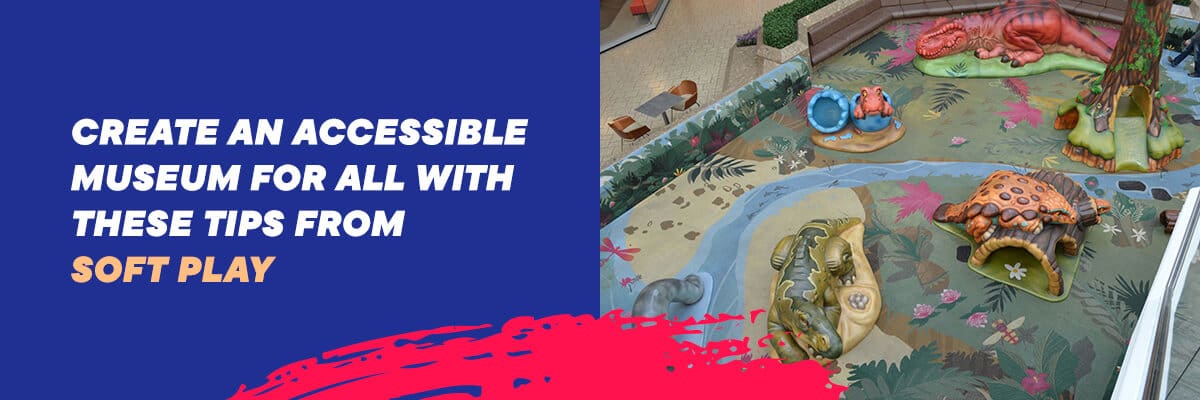
Create an Accessible Museum for All With These Tips from Soft Play
Prioritizing accessibility is one of the best ways you can improve your museum. Consider these tips to make your organization inclusive and welcoming to more visitors.
At Soft Play, we manufacture ADA-compliant indoor playground equipment that can increase your museum’s accessibility. For more than 30 years, we’ve provided our customers with durable, high-quality indoor play equipment to transform their guests’ experiences.
We can help your museum expand its business with play structures tailored to your unique space. Contact Soft Play to learn more about accessibility in museums.


